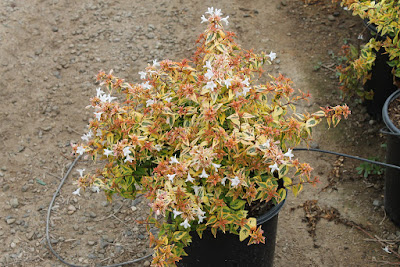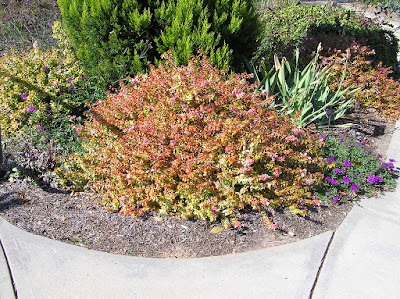Abelia kaleidoscope also called as Abelia × grandiflora 'Kaleidoscope', is a hybrid in the genus Abelia. This hybrid was first discovered by Randy Lindsey (Propagator at Panoramic Farm USA) as a sport on the well known Abelia × grandiflora ‘Little Richard’.
Abelia kaleidoscope also called as Abelia × grandiflora 'Kaleidoscope', is a hybrid in the genus Abelia. This hybrid was first discovered by Randy Lindsey (Propagator at Panoramic Farm USA) as a sport on the well known Abelia × grandiflora ‘Little Richard’.
IDENTIFY ABELIA KALEIDOSCOPE PLANT
Abelia kaleidoscope carries with it all the wonderful attributes of it parent - dense, compact growth habit with a high foliage retention during the dormant winter months. The really stand out attraction of 'Kaleidoscope', however, is the dynamic color it brings to the garden landscape.
New, variegated growth emerges as bright yellow with a light green center throughout spring gradually turning to golden yellow with deeper green markings into the summer months intensifying in colour rather than bleaching from long, hot summer days.
By autumn this combination turns to a bright orange to fiery red throughout the winter months extending until the early spring. These colours are further highlighted by the brilliant red stems and the abundance of dainty white flowers first appearing in summer.
Abelia x grandiflora ‘Kaleidoscope’ is also one of the longest flowering abelias with delicately fragrant white blooms that will perfume your garden from spring through autumn.
ABELIA KALEIDOSCOPE PLANT CARE AND CULTURE
Cultural information should only be used as a guide, and should be to be adapted to suit you. Your physical location; where you grow your plants, how much time you have to devote to their care, and many other factors, will need to be taken into account. Only then can you decide on the cultural methods that best suit you and your plants.
Light:
Abelia kaleidoscope plant grow well in full sun to part shade. A minimum of 6 hours direct sunlight is recommended for best foliage density and foliage color.
Temperature:
In summer, the temperature should be at 20-25 ℃. This plant need a rest period in winter with the temperature drop to 10-15 ℃.
Substrate and growing media:
Abelia × grandiflora 'Kaleidoscope' can be grown in the ground or in container. A well-drained soil is essential. As with so many other types of ornamental plants, constantly soggy or wet soil can cause root rot and other harmful plant diseases. The substrate can be turf, leaf soil, humus, peat and sand (in the ratio 1: 1: 1: 1: 1) with weak acidity (ranging between 5.0 to 7.5 on the pH scale).
Watering:
From the beginning of spring to autumn, this shrub need water plentifully, sometimes sprayed in hot weather. In winter, water carefully, making sure that the top layer of the soil does not dry out completely.
Fertilizer:
From spring to autumn, every two weeks feed the plant with mineral and organic fertilizers for indoor plants of usual concentration.
Rest period:
Abelia kaleidoscope need a rest period from October-March. In this time the temperature should be at 10-15 ℃, watering limited, no fertilizer and increase the level of light.
Pruning:
Abelia kaleidoscope is growing very fast and under favorable conditions for the spring-summer season gives a big increase. In order for the plant to have a more magnificent crown, at the end of winter - early spring it is cut to half the height of the shoots.
Propagation:
This shrubs is propagated by seeds and cuttings: Seeds are sown in January, seedlings grow quickly and in the same year, young plants can bloom. It can also reproduces in spring with apical stem cuttings, as well as shoots remaining after pruning. In order for the cuttings to be rooted better and faster, they are placed in a light substrate (sand, peat, perlite) maintaining the temperature at 20-25 ℃. Young plants grow into a beautiful bush and bloom in the same summer.















COMMENTS